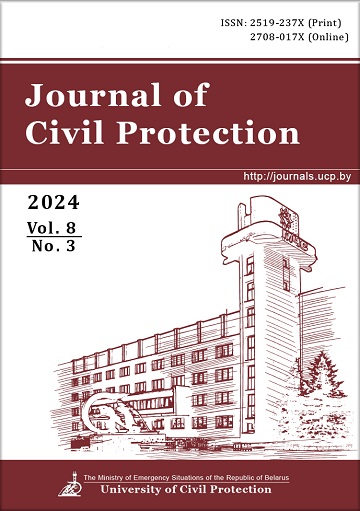Particularities of the occurrence of large fires at oil and gas facilities and methods of reducing emergency CO2 emissions
DOI:
https://doi.org/10.33408/2519-237X.2024.8-3.325Keywords:
hazardous production facility, large fires, fire safety, dangerous factors of fire, carbon dioxide, carbon footprint, photosynthesisAbstract
Purpose. Research of theoretical and practical issues concerning the increased emission of carbon dioxide into the atmosphere as a result of large fires at economic facilities related to the handling of hydrocarbon fuels, as well as the development and testing of methods to reduce it.
Methods. The facts of large fires at the infrastructure of hazardous production facilities related to the handling of organic fuels, which became sources of significant atmospheric emissions of carbon dioxide, one of the most powerful greenhouse gases in terms of negative impact, were analyzed. The analysis of accidents that occurred in 2014-2023 in the Russian Federation at the facilities of pipeline transportation of organic fuels and tanks with oil and petroleum products was carried out. An innovative methodology for reducing the carbon footprint from large fires was proposed and presented with positive results of application experiments.
Findings. It has been established that the majority of accidents at the research facilities are associated with the occurrence of fires, as well as explosions of fuel-air mixtures accompanied by ignitions of combustibles. It is shown that many different causes, from those of technical nature to militarized terrorist attacks on oil and gas complex facilities, «break» the technological chains of fuel movement from production to consumption, causing accidental burning of gas, oil and oil products. It is proposed to consider the negative impact from emergency fires of organic fuels in terms of formation of a significant contribution to the emission of carbon dioxide as a dangerous factor of indirect delayed action fire. Application of the developed methodology leads to an increase in the total photosynthetic potential of plants and, accordingly, their absorption of carbon dioxide from the atmosphere.
Application field of research. Investigation of the processes of accidents, fires and explosions, development of ways to reduce hazardous effects on the environment, development of methodological foundations and regulations aimed at ensuring fire safety of defense objects.
References
Abduragimov I.M. Pozhar gazovogo fontana na ulitse Ozernoy [Gas fountain fire on Ozernaya Street]. Fire and Explosion Safety, 2012. Vol. 21, No. 2. Pp. 46–53. (rus). EDN: https://elibrary.ru/PAELBX.
Ivakhnyuk S.G. Kaskadnost' vzaimnykh vozniknoveniya i razvitiya chrezvychaynykh situatsiy – rezul'tat nauchno-tekhnicheskogo progressa [Cascading mutual occurrence and development of emergency situations – the result of scientific and technological progress]. Problems of risk management in the technosphere, 2022. No. 1 (61). Pp. 67–77. (rus). EDN: https://elibrary.ru/YQSTAM.
Uroki, izvlechennye iz avariy [Lessons learned from accidents]. Federal Service for Environmental, Technological and Nuclear Supervision (Rostechnadzor). Available at: http://www.gosnadzor.ru/industrial/oil/lessons (accessed: May 23, 2024). (rus)
Bubnov V.P. Ekologicheskaya otsenka vozdeystviya vrednykh vybrosov (sbrosov) pri szhiganii organicheskogo i yadernogo topliva na okruzhayushchuyu sredu [Ecological assessment of emissions (discharges) effect on environment at burning organic and nuclear fuels]. Proceedings of the National Academy of Sciences of Belarus. Physical-technical series, 2010. No. 4. Pp. 70–73. (rus). EDN: https://elibrary.ru/ZHJMOR.
Komissarov G.G. Fotosintez: fiziko-khimicheskiy podkhod [Photosynthesis: a physico-chemical approach]. Moscow: Lenand, 2022. 224 p. (rus)
Kokieva G.E. Sovershenstvovanie tekhnologii vyrashchivaniya zelenykh kul'tur na rassadno-salatnykh kompleksakh zimnikh teplits [Improving the technology of growing green crops for the seedling and salad complex of winter greenhouses]. Stolypinskiy vestnik, 2022. Vol. 4, No. 4. Article 59. (rus). EDN: https://elibrary.ru/SIZSXE.
Ibraimov T.K., Mamatov E.U., Asanova E., Tashpolotov Y.T., Sadykov E. Vliyanie aktivirovannoy elektricheskim polem vody na pokazateli razvitiya rasteniy [Effect of water activated by electric field on plants development indicators]. Bulletin of Science and Practice, 2022. Vol. 8, No. 5. Pp. 67–72. (rus). DOI: https://doi.org/10.33619/2414-2948/78/07. EDN: https://elibrary.ru/FOSOGO.
May Ch.B. Vliyanie peremennogo elektricheskogo polya na fiziko- khimicheskie svoystva vody v reaktsii fotosinteza [The influence of an alternating electric field on the physico-chemical properties of water in the photosynthesis reaction]. PhD сhem. sci. diss. Synopsis: 02.00.04. St. Petersburg State Institute of Technology. Saint-Petersburg, 2018. 21 p. (rus)
Basova E.A., Ivakhnyuk S.G. Nauchnye innovatsii po obespecheniyu razvitiya otechestvennogo sel'skokhozyaystvennogo proizvodstva [Scientific innovations to ensure the development of national agricultural production]. Import substitution, scientific, technical and economic security: proc. of V Intern. scientific-technical conf. «Minsk Scientific readings», Minsk, December 7–9, 2022; in 3 volumes. Minsk: Belarusian State Technological University, 2022. Vol. 3. Pp. 120–126. (rus). EDN: https://elibrary.ru/XZSOID.
Ivakhnyuk S.G., Koroleva L.A. Nauchno-tekhnicheskie innovatsii po snizheniyu kontsentratsii tekhnogennogo CО2 v atmosfere za schet povysheniya ego absorbtsii [Scientific and technical innovations to reduce the concentration of technogenic CО2 in the atmosphere by increasing its absorption]. Problems of risk management in the technosphere, 2022. No. 2 (62). Pp. 69–79. EDN: https://elibrary.ru/ZNMBWG.
Ivakhnyuk G.K., Matyukhin V.N., Klachkov V.A., Shevchenko A.O., Knyazev A.S., Ivakhnyuk K.G., Ivanov A.V., Rodionov V.A. Sposob i ustroystvo upravleniya fiziko-khimicheskimi protsessami v veshchestve i na granitse razdela faz [Method and device for controlling physico-chemical processes in matter and at the interface of phases]: patent RU 2479005C2. Published April 10, 2013.
Krishnan A., Nighoykar A., Kandasubramanian B. Emerging towards zero carbon footprint via carbon dioxide capturing and sequestration. Carbon Capture Science & Technology, 2023. Vol. 9. Article 100137. DOI: https://doi.org/10.1016/j.ccst.2023.100137.
Onyeaka H., Miri T., Obileke K., Hart A., Anumudu C., Al-Sharify Z.T. Carbon footprint minimization using microalgae as a biological means of capture. Carbon Capture Science & Technology, 2021. Vol. 1. Article 100007. DOI: https://doi.org/10.1016/j.ccst.2021.100007.
Pessarrodona A., Howard J., Pidgeon E., Wernberg T., Filbee-Dexter K. Carbon removal and climate change mitigation by seaweed farming: A state of knowledge review. Science of the Total Environment, 2024. Vol. 918. Article 170525. DOI: https://doi.org/10.1016/j.scitotenv.2024.170525.
Singh S., Kiran B.R., Mohan S.V. Carbon farming: a circular framework to augment CО2 sinks and to combat climate change. Environmental Science: Advances, 2024. Vol. 3. Pp. 522–542. DOI: https://doi.org/10.1039/d3va00296a.
Bose A., O'Shea R., De S., Murphy J.D. Carbon capture by photosynthesis of plants. Reference Module in Earth Systems van Oossanen and Environmental Sciences, 2023. DOI: https://doi.org/10.1016/B978-0-323-93940-9.00052-9.
Yoshida H., van Oossanen S., Barbosa M.J., Janssen M. Photosynthesis of chlorella sorokinskaya, limited by light and carbon. Algal Research, 2023. Volume 69. Vol. 69. – Article 102934. DOI: https://doi.org/10.1016/j.algal.2022.102934.
Li S., Li X., Ho S.-H. How to enhance carbon capture by evolution of microalgal photosynthesis? Separation and Purification Technology, 2022. Vol. 291. Article 120951. DOI: https://doi.org/10.1016/j.seppur.2022.120951.
Xie Y., Khoo K.S., Chew K.W., Devadas V.V., Phang S.J., Lim H.R., Rajendran S., Show P.L. Advancement of renewable energy technologies via artificial and microalgae photosynthesis. Bioresource Technology, 2022. Vol. 363. Article 127830. DOI: https://doi.org/10.1016/j.biortech.2022.127830.
Published
How to Cite
License
Copyright (c) 2024 Basova E.A., Ivakhnyuk S.G., Koroleva L.A., Semenov V.V.

This work is licensed under a Creative Commons Attribution-NonCommercial 4.0 International License.




















